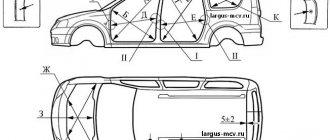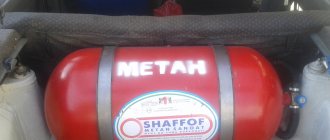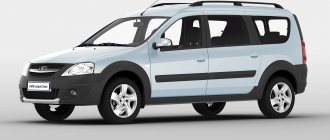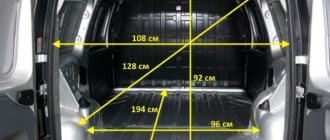When purchasing a particular vehicle, a person always adheres to certain goals. In the case of purchasing a Lada-Largus, as a rule, motorists want to get a roomy and easy-to-use car.
While this model has proven itself in terms of convenience, there is not much information about its dimensions. In today’s material, our resource decided to take a closer look at the dimensions of different components of the Lada-Largus and, in general, the overall dimensions of the car. At the same time, we focus attention not only on technical information, but also on reviews from model owners. Well, let's get started.
Dimensions of Lada Largus Cross, dimensions, ground clearance, ground clearance of Lada Largus Cross
The dimensions of the Lada Largus Cross differ little from the dimensions of the regular Largus.
The plastic body kit around the body did not significantly change the dimensions of the body. Of course, the main indicator that increased was the ground clearance of the Largus Cross. When the car is empty, this figure is 21 centimeters; when fully loaded, the ground clearance decreases to 17 centimeters, which is also not bad for our roads. The Largus Cross version, which is offered to customers, has a 7-seater interior. Huge possibilities for transforming the interior space, roof rails, and high ground clearance make the already unique car unrivaled in this price category. The length of the Lada Largus Cross is 4470 mm, width 1750 mm, while the wheelbase is huge for a car of this length, it is 2905 mm. A special feature of the Lada Largus Cross is the presence of standard 16-inch wheels; we remind you that on a regular station wagon they are either R14 or R15. Larger wheels and suspension upgrades have increased ground clearance by 25 mm.
The trunk of Largus Cross deserves a separate discussion. In the 7-seater version, it holds only 135 liters, but if the two rear rows of seats are folded, the loading volume increases to 2350 liters. The intermediate variant holds 560 liters when only the last third row of seats is folded down.
Below are the detailed dimensions of Largus Cross.
Dimensions, weight, volumes, ground clearance of Lada Largus Cross
- Length – 4470 mm
- Width – 1750 mm
- Height – 1636 mm
- Curb weight – 1370 kg
- Gross weight – 1850 kg
- Base, distance between front and rear axle – 2905 mm
- Front/rear wheel track – 1469/1466 mm
- The minimum trunk volume of the Lada Largus Cross is 135 liters
- Largus Cross trunk volume with the third row of seats folded is 560 liters
- The maximum trunk volume of the Lada Largus Cross with all seats folded is 2350 liters
- Fuel tank volume – 50 liters
- Tire size – 195/65 R16
- Ground clearance or ground clearance of the Lada Largus Cross when fully loaded is 170 mm (without load 210 mm)
As a result, Avtovaz offers a very practical, roomy car with high ground clearance. Although the Largus Cross does not have 4x4 all-wheel drive, even with one front-wheel drive the car is very convenient when operating on bad roads. Considering that most front-wheel drive inexpensive crossovers are more expensive than the Largus Cross and do not have a 7-seater interior, we can safely say that the Lada Largus Cross will sell well.
Body: dimensions, features
This is a standard passenger station wagon, available in 2 versions: 5- and 7-seater. The body dimensions of the Lada Largus station wagon are as follows (in mm):
- Body length Lada Largus 4470.
- The width of the car is 1750 (Largus dimensions including rear view mirrors – 2003).
- Height – 1636 (height including roof rails 1670).
- The luggage compartment volume is 135 liters (it can be significantly increased by folding the rear seats).
- The ground clearance of this AvtoVAZ model is 18 cm (at full load - 15 cm).
With such dimensions, Largus has a simple exterior, essentially repeating the features of the 7-seater Dacia Logan MCV station wagon. It meets the basic ideas of a comfortable, budget car for the whole family - its design is simple, laconic, and devoid of pretentiousness. The control dimensions of the car basically repeat the dimensions of the first generation Renault Logan.
Interior
All-wheel drive Lada-Largus appearance, when it appears, technical characteristics
As soon as you get into the cabin, you immediately see that nothing major has been changed in the interior. The driver's seat is still comfortable and can accommodate drivers of all sizes and shapes. In some configurations, the chair may have adjustable lumbar support and a steering column with settings in the vertical plane. To set the seat position, you can use simple adjustments.
The front panel, as well as the electronic equipment, remains the same. Among the features is the horn. It is set in French, and for Russians this is a little unusual. Its button is now at the end of the right steering column toggle switch.
dimensions of the cargo compartment, trunk volume
Lada Largus Cross
On a regular Lada Largus van, the body dimensions are selected so that Euro pallets can be transported. We are talking not only about the space between the pillars, which are spaced 108 cm apart, but also about the distance between the wheel arches. It is 96 cm, and one pallet takes 80. The distance from the rear doors to the partition generally approaches two meters! A little more and it would have been possible to fit a couple of Euro pallets. Here we will look at how to remove the partition between the body and the cabin, and at the same time remove the inner bottom of the body. The first is needed for transporting long cargo, the second is also used for some reason.
We study the fastening of partitions and floors. Everything is shown in one video.
Linear dimensions of the cargo compartment of the Lada Largus van
All the sizes you need to know are shown in the photo. The van doors here are fixed at an angle of 90 degrees, but they can be opened all the way to 180. They are fixed in either of the two positions.
Luggage compartment of a Largus van
Let's list everything that is marked in the figure:
- The greatest height of the opening is 92 cm;
- Opening width – 108 cm;
- The distance “from arch to arch” is 96 cm;
- The distance from the edge of the threshold to the partition is 194 cm.
If you lay sheets diagonally, the width of the sheet should be less than 130 cm.
When the partition remains in place, the internal volume of the Lada Largus van is 2540 liters. Load capacity is 725 kg. These figures are indicated by AvtoVAZ.
In fact, the maximum lifting capacity exceeds a ton. It all depends on the road conditions and driving style.
Unfasten the partition or part of it
The partition separating the body and the cabin consists of two halves. They can be removed separately. Both parts are screwed to the body with screws designed for a 13mm key size. Of course, you need a socket wrench.
Screws 1 were hidden under the casing
The four screws on the left and right are located on the cab side. And to unscrew them, remove the casing.
All actions with cladding
The left part of the septum is removed after the right. To remove only the left half, first remove both, and then mount the right sash back. Based on this, immediately decide where you will remove the trim - only on the right or on both sides.
The volume of the body on the Lada Largus van cannot be greatly increased, even if the partition is completely removed. But without the partition, by removing the seat, it will be possible to transport loads 3 meters long.
So, let's start dismantling the trim: you need to remove the seat belt (key “17”), and then unscrew one self-tapping screw. A Torx T20 wrench is suitable for the self-tapping screw.
Two parts “1” prevent the removal of casing “2”
It is necessary to unscrew all the parts numbered 1. And the casing will have to be removed, overcoming the resistance of the clamps.
Removing the partition
First, unscrew the four screws shown at the beginning of the chapter (key “13”). Then with the same key they go into the body.
All fasteners are the same
As you can see, both halves are held on three sides: top, bottom, middle. The number of screws will be as follows: four at the top and bottom, five at the seam between the sashes. Work order:
- Completely unscrew the four screws on top;
- While holding the nuts on the seam, unscrew the screws from the cabin side;
- The lower screws are unscrewed 2-3 turns. Then all parts are disengaged.
Let us remind you that the right wing can be removed separately. We wish you success.
Increasing the volume of the cargo compartment (removing the excess part on the floor)
The cargo compartment volume of the Lada Largus van can be increased. To do this, remove the floor covering.
There are two types of fasteners here
We will need special Torx keys, without which the screws cannot be unscrewed: Torx T30 and T40.
Study the picture carefully:
- T40 caps (2) are located at the corners, as well as on the line between the arches;
- The remaining screws (1) are designed for Torx T30 keys.
Removing the trim will be easy. And when you install it, make rubber gaskets. They are fixed to the ends of the frame so that the casing does not rust.
The removable floor (cladding) consists of two halves - left and right. First, according to tradition, the right one is removed.
Articles
- Floor fixing screw T30 – 7703008207;
- Floor fixing screw T40 – 7703008162;
- Floor panels, left and right – 6001548794 and 6001548795 respectively;
- Partition fastening screw (removable) – 7705096068;
- Partition mounting screw (non-removable) – 6001549488;
- Nut M6x100 (seam) – 6001549489;
- Left and right partition – 6001549485 and 6001549486 respectively.
Unfasten the partition or part of it
The partition separating the body and the cabin consists of two halves. They can be removed separately. Both parts are screwed to the body with screws designed for a 13mm key size. Of course, you need a socket wrench.
Screws 1 were hidden under the casing
The four screws on the left and right are located on the cab side. And to unscrew them, remove the casing.
Salon of Lada Largus Cross photo, trunk of Lada Largus Cross, capacity, trunk volume
Tractor MTZ-80 description, technical characteristics, engine and reviews
The interior of the Lada Largus Cross will delight its owner with bright orange inserts, which are the main distinguishing feature, of course, if you compare the Cross version with the regular Lada Largus station wagon. Let us tell you right away that the Largus Cross modification has three rows of seats, that is, it is a 7-seater car. Perhaps the interior capacity and trunk volume of the Largus Cross are the main advantages of the car, apart from the high ground clearance. So if you fold the two rear rows of seats, the loading volume will be 2350 liters. If you fold only the third row, the trunk volume is 560 liters. In the 7-seater version of the Largus Cross, the luggage compartment is purely symbolic and amounts to 135 liters.
Below is a photo of the interior and trunk of the Lada Largus Cross.
In principle, the interior of the new Largus Cross is no different from the luxury version of the regular Largus. Inside this car you will find power windows, air conditioning, a comfortable ceiling shelf above the passengers' heads, and the center console has a built-in audio system (FM, CD, MP3, AUX, USB, Bluetooth, Hands free). The front seats are heated. The third row of seats can be easily removed if necessary, without the use of any tools. Don't forget about all kinds of pockets and cup holders. In general, the fabric interior of the Lada Largus Cross is very practical. The plastic inside the car is also very good and fits without large gaps.
Advantages and disadvantages
To make the right decision, you need to study not only the advantages, but also the disadvantages of the model. The owners, who have extensive experience in operating Largus, found one drawback. The car manufacturer did not adjust the interior of the station wagons in such a way that their owners would have the opportunity to transport large loads. If the driver nevertheless decided to load a large object into his car, then the cargo often caused damage to the interior.
Otherwise, Lada Largus owners are satisfied with everything in their cars. Among the advantages of a Russian car are the following:
- ease of loading;
- optimal dimensions;
- the ability to increase trunk capacity by removing the seats;
- high load capacity;
- possibility of modernization.
Drivers universally note the practicality and convenience of the LADA Largus trunk. Its size is quite enough to demonstrate the functionality of a domestic car, which allowed it to become a leader among its closest competitors. The manufacturer managed to competently and rationally approach the arrangement of the body space, which allows Largus to successfully transport large objects and indicates the enviable carrying capacity of the model.
Lada Largus is recommended for those drivers who want to get a car with the best consumer properties and technical characteristics.
Competitors of Lada Largus
The model under consideration is unique in many ways. Like the prototype from Romania, the joint brainchild of the domestic auto industry and the Renault concern is the cheapest station wagon with six passenger seats. There are simply no alternatives to it, judging by the cost.
Lada Priora with a station wagon body? Yes, among the advantages of this model are a comparable price and good appearance. But there are only 5 seats, and the loading volume does not exceed a modest 770 liters even with the rear seats folded. And comparing a typical AvtoVAZ product with excellent potential, but quality that ruins a good idea, with a high-class car from Renault is not entirely correct.
Chevrolet Lacetti, although it is a good sedan, its performance in the station wagon form factor leaves much to be desired. The price is noticeably higher, and the useful loading volume is too modest. This is, rather, a representative of the golf class, rather than a semi-commercial mini-truck or minibus.
A car from the Middle Kingdom is a Cherry Karry and is cheaper and can carry more luggage. But this is just China: ancient culture, powerful economy and mediocre quality of cars.
In the near future, mass production of a very similar model is expected - the Ford B Max: a car with the same capacity, reliable brand image and attractive appearance. Time will tell whether it will be able to compete with the Lada Largus, but for now an unusual conclusion arises: today there are no Lada Largus competitors with adequate cost and characteristics on the market! However, SUVs and minibuses can be taken into account, but comparing the model with cars of this type is the topic of a separate article.
A look into the future
Today Samotlor-NN produces about one hundred cars per month. There are great hopes for Cube: they want to make 5-10 thousand cars a year. The pre-announced price of a basic van with a 16-valve engine is 899,000 rubles. And, for example, a fully equipped version for dog handlers will cost 1.3 million rubles. The cars will be sold through the AVTOVAZ dealer network, while maintaining the factory warranty.
With comparable capacity, the domestic Sobol is several hundred thousand more expensive. Competitors - foreign cars - are only Citroen Berlingo and Peugeot Partner, but they are offered in factory versions, without modifications, and prices start from 1,119,000 rubles.
There are many potential clients, and the manufacturer places special hopes on government agencies - doctors, police, Russian Post, Sberbank. Government procurement rules make foreign-assembled cars inaccessible to them, and factory versions are not always suitable for the needs of the “profession”. And here Samotlor-NN will come in very handy with its Cube.
Disadvantages of modern cars
A car is no longer considered a luxury, but a means of transportation. Modern models quickly and comfortably transport people and various cargoes. Almost all cars have both pros and cons. Environmentalists consider road transport as the main source of air smoke in cities. Cars become the source of two problems for the entire metropolis - traffic jams and the smog that we breathe.
In a new car, the engine belts are poorly tightened
Expensive repairs of modern cars force you to spend a considerable amount of money, despite careful driving and proper maintenance. Even a small dent repair costs at least 2,000 rubles. Cash injections increase not only in the process of engineering corrections, but also protective measures, such as purchasing a garage and paying for utilities for the use of light in it, installing an alarm system, and paying for parking spaces. There is also a waste of money on various accessories for your car.
In the modern world, where each unit of resource becomes more expensive every minute, car manufacturers are trying to reduce production costs, which inevitably affects quality. Therefore, the question of significant shortcomings is relevant when it becomes possible to return the money paid for a purchased low-quality car. The Russian Federation Law “On the Protection of Consumer Rights” identifies the following types:
- a flaw that cannot be eliminated when it is not possible to eliminate it in the usual way;
- a drawback that requires huge expenditures of money and time to eliminate, when the time spent on repairs is disproportionately spent and a huge price that corresponds to the cost of the car itself;
- a defect identified for the second time, when cases of detection of disadvantages are repeated constantly and do not make it possible to operate the vehicle.
Are there any significant differences between the Lada Largus versions?
Before a detailed examination of the technical characteristics of the “Russian Logan”, it is important to note that its versions do not have significant differences from each other in terms of technical parts. The fact is that various variations of the Lada Largus were released by AvtoVAZ in order to satisfy the desires of the largest number of car enthusiasts
The differences between them lie not in the principles of organizing the technical part of the car, but in its design. In fact, all versions of Largus are the same car, except for the following nuances:
- the basic variation of the station wagon model is represented by a standard 5-seater station wagon;
- “minivan”, also known as “high-capacity station wagon”, differs from the basic variation of the model only in that it is supplemented with two passenger seats - it has 7 seats;
- the “van” version is designed for transporting large cargo and is devoid of all passenger seats, except for the passenger seat next to the driver - it is double, and the suspension is also slightly strengthened in this variation;
- Largus-Cross, in turn, is the most different car from other versions of the model; it has a reinforced structure and high ground clearance, as it is intended for use in rough terrain.
Apart from those presented above, there are no differences between the car versions. As a result, the technical characteristics of the model can be considered in a general manner, which will be done below.
Basic dimensions
The main indicators of the dimensions of any car, first of all, are understood as the dimensions of the body. Everyone knows that Lada-Largus is a model made on the Renault Dasia Logan MSV platform (2006 variation), but completely adapted for the Russian market. Considering such a relationship between the two cars, it seems surprising that there are some differences in their dimensions, even if they are not significant.
Despite the fact that the Lada-Largus is available in three body variations: a station wagon (5 seats), a minivan (7 seats) and a van (2 seats) - the dimensions of all variations are the same, with the exception of height. More precisely, the machine dimensions are as follows (in mm):
- length – 4470;
- width – 1750;
- width including side mirrors – 2003;
- height – 1636 (station wagon/minivan) and 1650 (van);
- height taking into account restylings - 1670 (station wagon/minivan) and 1686 (van);
- ground clearance - 145-175, which depends on the load of the car (210-170 - for Lada-Largus Cross);
- wheelbase - 2900;
- front track - 1469;
- rear track - 1466;
- front/rear overhangs – 797/771.
Having analyzed the dimensions of the car, we can conclude that the car is quite large for a B-class. Such circumstances emerge not only in theory, but also in practice, judging by the reviews of the owners. Many of them note that the dimensions fit quite well into the aesthetic concept of the car and do not cause any inconvenience during its operation.
Unpleasant features of the Lada Largus
Malfunctions of the Lada Largus sometimes appear immediately after purchase, on the way home. An unpleasant disadvantage can be the wire of the starter solenoid relay that is shorted on the motor. This occurs due to rubbing of the insulating material. The instrument panel does not reflect the reaction to turning the key in the ignition switch, the car does not start. The hard rubber of the CV joint boots stretches and breaks in the winter.
By 3000 km, problems arise with the generator, and a hum appears in the engine. The reason for this disadvantage may be weak belt tension. It needs adjustment and, possibly, replacement of the generator rollers and bearings. The camshaft and crankshaft seals may wear out, reverse sensors may fail, ball joints may knock, the front wheel bearings may need to be replaced, or many other problems may arise that are aesthetic in nature or affect passenger comfort.
The seat fastenings in the trunk are in the way
The large trunk allows you to transport a huge amount of luggage, but if you remove the third row of seats, their fastenings remain on the floor, and during loading you can easily damage the integrity of the luggage. The spare wheel is not located very conveniently: from the street, under the trunk floor, as a result of which the Largus' ground clearance decreases. The front seats are uncomfortable, the upper part of the torso of the seated person cannot rest against the body of the chair, the back hangs in the free space.
The second row of seats has seat belt buckles sticking out of the cushion recesses; the passenger is forced to sit on them, which is not very comfortable. The passenger of the second row, whose seat is located in the middle, is forced to use seat belts, the fastening of which is located on the ceiling of the cabin. The gearshift lever is located next to the center console switches, which in itself causes major shifting problems.
Some aspects of the backlight color scheme are not well thought out, and the red color puts unpleasant pressure on the driver’s eyes. The downside is that the dashboard is made of a material that rumbles and creaks. The height of Largus makes it difficult to drive at high speeds in places with a side wind, which knocks the car off course, using the body of the car as a sail. In this case, leveling the vehicle is difficult, since it has a light and sensitive steering wheel.
The quality of painting leaves much to be desired; in some places, when pressing on the surface, the paint begins to peel off. This problem occurs at the top of the doorways, at the point where they are attached to the body from the inside, under the hood. When using first and second gears, a knock is heard from the bottom; most likely, this is the knocking of the muffler, which after a few thousand kilometers begins to rust.
Linear dimensions of the cargo compartment of the Lada Largus van
All the sizes you need to know are shown in the photo. The van doors here are fixed at an angle of 90 degrees, but they can be opened all the way to 180. They are fixed in either of the two positions.
Luggage compartment of a Largus van
Let's list everything that is marked in the figure:
- The greatest height of the opening is 92 cm;
- Opening width – 108 cm;
- The distance “from arch to arch” is 96 cm;
- The distance from the edge of the threshold to the partition is 194 cm.
If you lay sheets diagonally, the width of the sheet should be less than 130 cm.
When the partition remains in place, the internal volume of the Lada Largus van is 2540 liters. Load capacity is 725 kg. These figures are indicated by AvtoVAZ.
In fact, the maximum lifting capacity exceeds a ton. It all depends on the road conditions and driving style.
Specifications
As noted earlier, Lada Largus was created on the basis of Renault Logan. Therefore, in terms of their design and technical characteristics, the cars are not just very similar, but real twins. Perhaps the main difference between them is the manufacturer's mark on the hood.
To be fair, it is worth noting that the Lada Largus is not a car that will please the motorist with its “racing” character and agility on the road. It is a typical station wagon: moderately playful, very stable and extremely easy to use.
The engine line of the model is represented by three units: two produced by Renault and one by AvtoVAZ. All engines are in-line, have four cylinders and a displacement of 1.6 liters. In general, the line looks like this:
- K7M (Renault) - 84-horsepower engine running on gasoline and meeting the requirements of EURO-4 econorms (max. speed - 156 km/h);
- VAZ-11189 (AvtoVAZ) - an 87-horsepower engine, also running on gasoline and meeting the requirements of EURO-4 econorms (max. speed - 156 km/h);
- K4M (Renault) - 102-horsepower engine, again running on gasoline and meeting the requirements of EURO-4 econorms (max. speed - 165 km/h).
All engines are equipped with the same gearbox - manual from Nissan (JR5 or JH3). The choice of engine depends on the choice of configuration and version of the purchased model and is carried out according to the principle: the better the car, the more powerful the engine. In any case, the average consumption and performance are quite similar for all engines and the differences in this indicator are not so significant (consumption per 100 km - 8-10 liters, acceleration to 100 km/h - 13-15 seconds). The chassis of the Lada Largus is stable on the road, but because of this you have to pay for the poor handling of the car. Structurally, the model’s suspension is a real “hodgepodge”, where there are parts from Russian, European, and Japanese production. It is worth considering that the “cross” and “van” versions have a reinforced chassis design. Moreover, Largus Cross is also endowed with greater clearance than its “model brothers”.
Important! In general, the technical characteristics of Largus are standard for its model concept. Despite this, the model has a significant advantage - it is assembled very well, and the quality of the parts will please many.
Off-road performance
Naturally, it is difficult to call a new car a crossover in the full sense. Ground clearance of 175 mm with a fully loaded body is an excellent figure, but as soon as you go off-road, you immediately remember the distance between the axles, which seriously limits the possibilities. In addition, AvtoVAZ does not plan to produce Largus-Cross 4x4. Still, this car is positioned as an economical family car. However, this is not only a universal machine with increased capacity. Now the kit also includes increased cross-country ability, as well as survivability.
The suspension can open completely here. It is possible to “ruin” it, but it is quite difficult to implement. In addition, different wheels were installed, which also contributed to an increase in ground clearance.
In general, such a car should have been available for Russian roads at the very beginning. Everything that has been done now could have been done much earlier. If you read what the owners of the Largus-Cross car write, the review of the car is generally positive. After all, it’s almost a foreign car. With this car everything is much simpler than with any other models. Just turn the key half a turn and the engine starts immediately.
The protective body kit fully justifies its purpose. It will be able to withstand winter snowdrifts without any problems, and will not be scratched by contact with branches. This is relevant for summer residents who regularly go to their plots.
They also speak positively about cross-country ability. Yes, the car does not have all-wheel drive, not even an imitation of it.
On country roads the five-speed gearbox with short gears helps a lot. However, there are no completely universal solutions and there cannot be. To get to the dacha you will also have to travel along the highway. The engine revs up and the cabin is filled with a roar.
In winter you need to be careful. This is because visibility deteriorates in winter. The wipers freeze up very quickly, and on the left you get an uncleaned area, behind which even a large truck can hide. In the rearview mirror, only the headrests and frozen swing doors are visible. Side mirrors get dirty quickly.
The Largus-Cross car itself, the technical characteristics of which we reviewed earlier, is something that is perfect for car enthusiasts without special ambitions. The engine's capabilities are sufficient for both on-road and off-road use. A spacious trunk will be a huge plus for commercial use, for travel enthusiasts and for summer residents. The car will also be appreciated by large families whose income is above average. Children will appreciate the spaciousness of the cabin, and men and women will appreciate the excellent sound of the media system. Everyone will love the interior and exterior, as well as the ability to drive on any road surface without any obstacles. So the Largus Cross is a car for our roads, with a Russian character and an affordable price.
Appearance
Car reviews always focus on appearance and design. Just a quick glance is enough to notice something animalistic in the exterior
Even the name seems to have been copied from zoological reference books. The characteristic features were now evident in appearance. But first things first.
If we forget the noisy and beautiful presentation of this new product and all the good things that were said in the direction of the crossover by the company’s management, a small test (“Largus Cross”) was more likely to disappoint than to confirm the joy and delight of the development engineers.
The manufacturers promised a lot. The station wagon body had to be significantly modified. But in the end, all the modifications made that were supposed to add the potential of an SUV to the car were black plastic linings that were installed on the front and rear bumpers. The sills and wheel arches were also painted black, and the door frames and body pillars were also covered with black film.
The appearance is complemented by light alloy wheels with a diameter of 16”, as well as oversized tires. At AvtoVAZ itself, the set of plastic elements was called “aggressive design.” Now car enthusiasts and owners will have to somehow live with this.
It’s a pity that we don’t know how this aggression, created on the basis of black unpainted plastic, is manifested. Representatives of the manufacturer could not explain this, especially since plastic does not have any special capabilities, just like the body kit.
In general, the crossover is the French-Romanian hit Logan MCV from 2006, but with new bumpers and a different radiator grille. There is not an ounce of any aggression in his appearance. On the contrary, the appearance is completely utilitarian.
The slightly angular and heavy rear end, vertical pillars and tailgates give the car the appearance of a commercial bus. Simple optics, a smooth and flat roof, primitive handles and mirrors – this is what completes the review of the appearance of not the most elegant and graceful car. But a certain roughness is still good for a new SUV.











